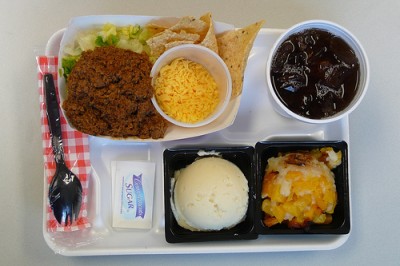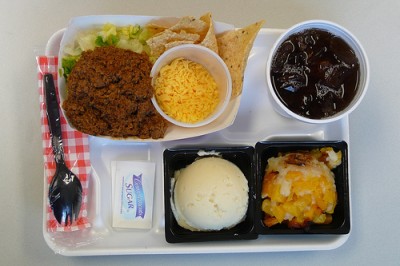 What will 6 cents change in this picture?“‘No machines until you get your lunch!’ an aide yells, trying to keep students from the bank of vending machines at the back of the cafeteria ringing with the siren call of Pop-Tarts and Cool Ranch Doritos.
What will 6 cents change in this picture?“‘No machines until you get your lunch!’ an aide yells, trying to keep students from the bank of vending machines at the back of the cafeteria ringing with the siren call of Pop-Tarts and Cool Ranch Doritos.
–From “Schools’ Toughest Test: Cooking,” by Kim Severson, The New York Times, Sept. 29, 2009
When I wrote about Senate ag committee chair Sen. Blanche Lincoln’s school lunch billl last week, I left out a key fact: the bill would force the USDA to regulate the stuff schools sell in vending machines.
That’s important. Schools peddle all manner of industrial crap in cafeterias: from high-fructose corn syrup-laden sodas to trashy chips and pastries.
But why do schools do that? Because they want to get kids hooked on junk food and make them overweight and sick? No. They do it because it’s really, really hard to put lunch on the table for kids on the miserly outlay they get from the federal government; and proceeds from the machines act as a subsidy to the lunch budget.
Right now, cafeterias get $2.68 per student for every free lunch they serve. Two-thirds of that goes to labor and overhead, leaving about 90 cents to spend per student on ingredients. The vending machines stand as an indictment to a Dickensian program.
And under Lincoln’s bill, which won bi-partisan approval in Lincoln’s committee this week, Dickensianism remains in place, despite the new rules on vending machines. As I reported before, Lincoln’s bill would add $450 billion over 10 years, or $450 million per year, to school lunch budgets. That’s less than half of President Obama’s budget request–which itself wan’t nearly enough. The USA Today has details on how Lincoln’s bill would work:
Those schools that implement the new [nutrition and safety] rules would get an additional 6 cents per meal added to their federal reimbursement rate. Current reimbursement rates, which give schools $2.68 for each lunch they serve, have not changed since 1973, except for inflation adjustment, and schools have long complained that they are insufficient.
Ouch. Six extra cents. Will that even keep up with inflation over ten years? As a carrot to inspire schools to follow new nutrition rules, that amount won’t even procure an extra carrot per kid. It should also be noted that recent food-safety scandals related to food, including the infamous pink-slime episode, can be directly related to miserly lunch budgets.
Thus is the bitter taste of “change,” I suppose, in an age of fiscal austerity. But pinching pennies isn’t always the fiscally responsible thing. Stiffing kids on school lunches today will likely generate massive costs down the road. The USA Today piece has a great map showing that in great swaths of the country, upwards of 77 percent of public-school kids rely on reduced-price or free lunches. This bill fails those kids. Yes, we can do better.



